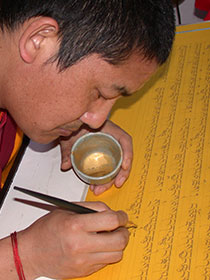- Home
- FPMT Homepage
Foundation for the Preservation of the Mahayana Tradition
The FPMT is an organization devoted to preserving and spreading Mahayana Buddhism worldwide by creating opportunities to listen, reflect, meditate, practice and actualize the unmistaken teachings of the Buddha and based on that experience spreading the Dharma to sentient beings. We provide integrated education through which people’s minds and hearts can be transformed into their highest potential for the benefit of others, inspired by an attitude of universal responsibility and service. We are committed to creating harmonious environments and helping all beings develop their full potential of infinite wisdom and compassion. Our organization is based on the Buddhist tradition of Lama Tsongkhapa of Tibet as taught to us by our founders Lama Thubten Yeshe and Lama Thubten Zopa Rinpoche.
- Willkommen
Die Stiftung zur Erhaltung der Mahayana Tradition (FPMT) ist eine Organisation, die sich weltweit für die Erhaltung und Verbreitung des Mahayana-Buddhismus einsetzt, indem sie Möglichkeiten schafft, den makellosen Lehren des Buddha zuzuhören, über sie zur reflektieren und zu meditieren und auf der Grundlage dieser Erfahrung das Dharma unter den Lebewesen zu verbreiten.
Wir bieten integrierte Schulungswege an, durch denen der Geist und das Herz der Menschen in ihr höchstes Potential verwandelt werden zum Wohl der anderen – inspiriert durch eine Haltung der universellen Verantwortung und dem Wunsch zu dienen. Wir haben uns verpflichtet, harmonische Umgebungen zu schaffen und allen Wesen zu helfen, ihr volles Potenzial unendlicher Weisheit und grenzenlosen Mitgefühls zu verwirklichen.
Unsere Organisation basiert auf der buddhistischen Tradition von Lama Tsongkhapa von Tibet, so wie sie uns von unseren Gründern Lama Thubten Yeshe und Lama Thubten Zopa Rinpoche gelehrt wird.
- Bienvenidos
La Fundación para la preservación de la tradición Mahayana (FPMT) es una organización que se dedica a preservar y difundir el budismo Mahayana en todo el mundo, creando oportunidades para escuchar, reflexionar, meditar, practicar y actualizar las enseñanzas inconfundibles de Buda y en base a esa experiencia difundir el Dharma a los seres.
Proporcionamos una educación integrada a través de la cual las mentes y los corazones de las personas se pueden transformar en su mayor potencial para el beneficio de los demás, inspirados por una actitud de responsabilidad y servicio universales. Estamos comprometidos a crear ambientes armoniosos y ayudar a todos los seres a desarrollar todo su potencial de infinita sabiduría y compasión.
Nuestra organización se basa en la tradición budista de Lama Tsongkhapa del Tíbet como nos lo enseñaron nuestros fundadores Lama Thubten Yeshe y Lama Zopa Rinpoche.
A continuación puede ver una lista de los centros y sus páginas web en su lengua preferida.
- Bienvenue
L’organisation de la FPMT a pour vocation la préservation et la diffusion du bouddhisme du mahayana dans le monde entier. Elle offre l’opportunité d’écouter, de réfléchir, de méditer, de pratiquer et de réaliser les enseignements excellents du Bouddha, pour ensuite transmettre le Dharma à tous les êtres. Nous proposons une formation intégrée grâce à laquelle le cœur et l’esprit de chacun peuvent accomplir leur potentiel le plus élevé pour le bien d’autrui, inspirés par le sens du service et une responsabilité universelle. Nous nous engageons à créer un environnement harmonieux et à aider tous les êtres à épanouir leur potentiel illimité de compassion et de sagesse. Notre organisation s’appuie sur la tradition guéloukpa de Lama Tsongkhapa du Tibet, telle qu’elle a été enseignée par nos fondateurs Lama Thoubtèn Yéshé et Lama Zopa Rinpoché.
Visitez le site de notre Editions Mahayana pour les traductions, conseils et nouvelles du Bureau international en français.
Voici une liste de centres et de leurs sites dans votre langue préférée
- Benvenuto
L’FPMT è un organizzazione il cui scopo è preservare e diffondere il Buddhismo Mahayana nel mondo, creando occasioni di ascolto, riflessione, meditazione e pratica dei perfetti insegnamenti del Buddha, al fine di attualizzare e diffondere il Dharma fra tutti gli esseri senzienti.
Offriamo un’educazione integrata, che può trasformare la mente e i cuori delle persone nel loro massimo potenziale, per il beneficio di tutti gli esseri, ispirati da un’attitudine di responsabilità universale e di servizio.
Il nostro obiettivo è quello di creare contesti armoniosi e aiutare tutti gli esseri a sviluppare in modo completo le proprie potenzialità di infinita saggezza e compassione.
La nostra organizzazione si basa sulla tradizione buddhista di Lama Tsongkhapa del Tibet, così come ci è stata insegnata dai nostri fondatori Lama Thubten Yeshe e Lama Zopa Rinpoche.
Di seguito potete trovare un elenco dei centri e dei loro siti nella lingua da voi prescelta.
- 欢迎 / 歡迎
简体中文
“护持大乘法脉基金会”( 英文简称:FPMT。全名:Foundation for the Preservation of the Mahayana Tradition) 是一个致力于护持和弘扬大乘佛法的国际佛教组织。我们提供听闻,思维,禅修,修行和实证佛陀无误教法的机会,以便让一切众生都能够享受佛法的指引和滋润。
我们全力创造和谐融洽的环境, 为人们提供解行并重的完整佛法教育,以便启发内在的环宇悲心及责任心,并开发内心所蕴藏的巨大潜能 — 无限的智慧与悲心 — 以便利益和服务一切有情。
FPMT的创办人是图腾耶喜喇嘛和喇嘛梭巴仁波切。我们所修习的是由两位上师所教导的,西藏喀巴大师的佛法传承。
繁體中文
護持大乘法脈基金會”( 英文簡稱:FPMT。全名:Found
ation for the Preservation of the Mahayana Tradition ) 是一個致力於護持和弘揚大乘佛法的國際佛教組織。我們提供聽聞, 思維,禪修,修行和實證佛陀無誤教法的機會,以便讓一切眾生都能 夠享受佛法的指引和滋潤。 我們全力創造和諧融洽的環境,
為人們提供解行並重的完整佛法教育,以便啟發內在的環宇悲心及責 任心,並開發內心所蘊藏的巨大潛能 — 無限的智慧與悲心 – – 以便利益和服務一切有情。 FPMT的創辦人是圖騰耶喜喇嘛和喇嘛梭巴仁波切。
我們所修習的是由兩位上師所教導的,西藏喀巴大師的佛法傳承。 察看道场信息:
- FPMT Homepage
- News/Media
-
- Study & Practice
-
-
- About FPMT Education Services
- Latest News
- Programs
- New to Buddhism?
- Buddhist Mind Science: Activating Your Potential
- Heart Advice for Death and Dying
- Discovering Buddhism
- Living in the Path
- Exploring Buddhism
- FPMT Basic Program
- FPMT Masters Program
- FPMT In-Depth Meditation Training
- Maitripa College
- Lotsawa Rinchen Zangpo Translator Program
- Universal Education for Compassion & Wisdom
- Online Learning Center
-
- Prayers & Practice Materials
- Overview of Prayers & Practices
- Full Catalogue of Prayers & Practice Materials
- Explore Popular Topics
- Benefiting Animals
- Chenrezig Resources
- Death & Dying Resources
- Lama Chopa (Guru Puja)
- Lama Zopa Rinpoche: Compendium of Precious Instructions
- Lama Zopa Rinpoche: Life Practice Advice
- Lama Zopa Rinpoche Practice Series
- Lamrim Resources
- Mantras
- Prayer Book Updates
- Purification Practices
- Sutras
- Thought Transformation (Lojong)
- Audio Materials
- Dharma Dates - Tibetan Calendar
- Translation Services
- Publishing Services
- Ways to Offer Support
- Prayers & Practice Materials
-
- Teachings and Advice
- Find Teachings and Advice
- Lama Zopa Rinpoche Advice Page
- Lama Zopa Rinpoche: Compendium of Precious Instructions
- Lama Zopa Rinpoche Video Teachings
- ༧སྐྱབས་རྗེ་བཟོད་པ་རིན་པོ་ཆེ་མཆོག་ནས་སྩལ་བའི་བཀའ་སློབ་བརྙན་འཕྲིན།
- Podcasts
- Lama Yeshe Wisdom Archive
- Buddhism FAQ
- Dharma for Young People
- Resources on Holy Objects
- Teachings and Advice
-
-
*If a menu item has a submenu clicking once will expand the menu clicking twice will open the page.
-
-
- Centers
-
- Teachers
-
- Projects
-
-
-
-
*If a menu item has a submenu clicking once will expand the menu clicking twice will open the page.
-
-
- FPMT
-
- Shop
-
-
-
The Foundation Store is FPMT’s online shop and features a vast selection of Buddhist study and practice materials written or recommended by our lineage gurus. These items include homestudy programs, prayers and practices in PDF or eBook format, materials for children, and other resources to support practitioners.
Items displayed in the shop are made available for Dharma practice and educational purposes, and never for the purpose of profiting from their sale. Please read FPMT Foundation Store Policy Regarding Dharma Items for more information.
-
-
26
FPMT Students Experienced that FPMT Family Feeling in Nepal

Gen Dondrub and FPMT Australia pilgrims at Jana Bahal Temple, which contains a statue of Avalokiteshvara, one of the most revered by Newari Buddhists, and small paintings of the 108 manifestations of Avalokiteshvara, Kathmandu, Nepal, February 2019. Photo by Mark Kinnear.
In February 2018 a group of FPMT students traveled together from Australia to Kathmandu, Nepal, for a pilgrimage led by Gen Thubten Dondrub*, FPMT resident teacher at Buddha House, an FPMT center in Australia. In addition to encountering Lama Zopa Rinpoche in Nepal, the pilgrims visited many holy places: Boudhanath Stupa; Namo Buddha Stupa; Swayambhunath Stupa; holy sites in Sankhu, Pharping, and Patan; Nagi Gompa; the Maratika Caves; and ancient city temples associated with the deities Tara and Vajrayogini. This story was compiled by some of the Buddha House pilgrims.
On February 3, 2018, twenty-two students from five FPMT centers in Australia—Buddha House; Hayagriva Buddhist Centre; Tara Meditation Centre; Vajrayana Institute; and Gyalwa Ensapa Broome Buddhist Study Group—flew into Kathmandu, Nepal, for the beginning of what turned out to be very auspicious twenty-one days of pilgrimage.
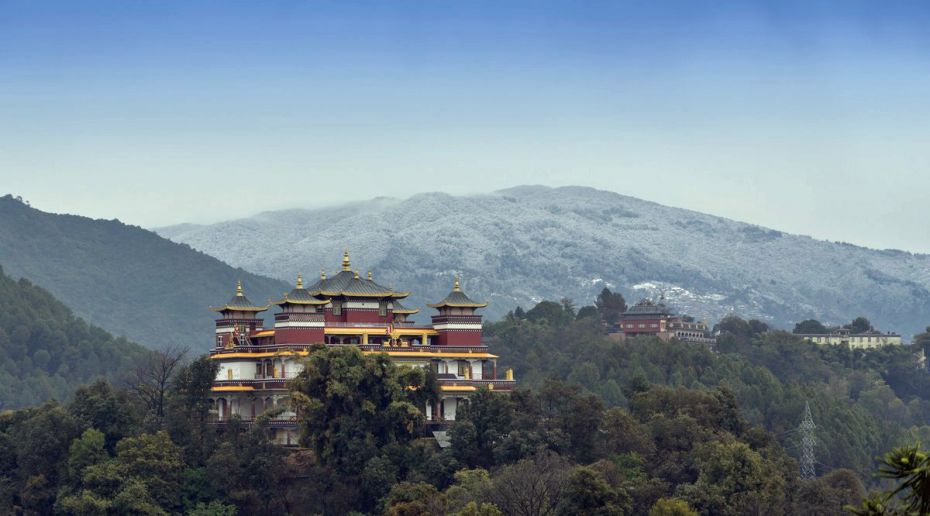
Snow in the mountains, a view from Kopan Monastery, Kathmandu, Nepal, February 2019. Photo by Ven. Lobsang Sherab.
Arriving at Kopan Monastery, the FPMT monastery in Kathmandu, around midnight, the group was greeted the next morning with a thrill—they discovered Lama Zopa Rinpoche was in residence at Kopan for Losar (Tibetan New Year) and would be there through to the Day of Miracles.
Lama Zopa Rinpoche advised in “Practices for Pilgrimage”: “How do we make pilgrimage as meaningful, useful and beneficial as possible? The main point of pilgrimage is to subdue our minds. By eliminating mistaken thoughts, not allowing the mind to be under the control of delusion, the mind is better able to actualize the lam-rim realizations, from guru devotion up to enlightenment.”
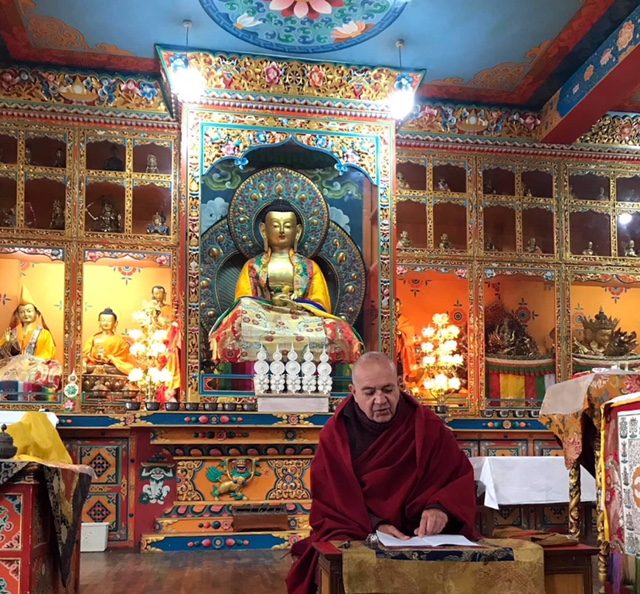
Gen Thubten Dondrub leading a short retreat on Orange Manjushri in the Tantric College Gompa at Kopan Monastery, Kathmandu, Nepal, February 2019. Photo by Sandy Faber.
Gen Thubten Dondrub began the pilgrimage with a strict pre-warning to those about to join him, saying, “You are not on a holiday.” We would be visiting the holy sites in Kathmandu, the Kathmandu Valley, and Maratika Caves, where we would recite prayers, mantras, and engage in practices including tsog offerings.
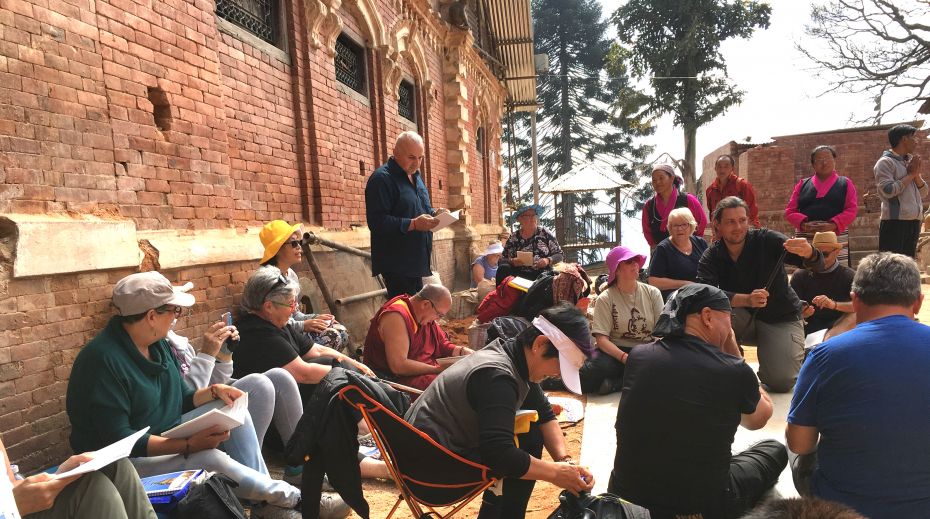
Gen Thubten Dondrub leading practices and tsog offerings, Sankhu, Nepal, February 2019. Photo by Peter Wagner.
Due to the kindness and great effort of Judy Wagner, Buddha House spiritual program coordinator, a portable altar, water bowls, and offerings were set up at each holy site—even if the tsog had to be guarded from cunning monkeys!
To fulfill Lama Zopa Rinpoche’s advice of not wasting time, Gen Thubten Dondrub made the most of our lengthy bus and jeep rides through Kathmandu traffic, leading Tara and Vajrasattva practices in the morning and dedications during the rides home.
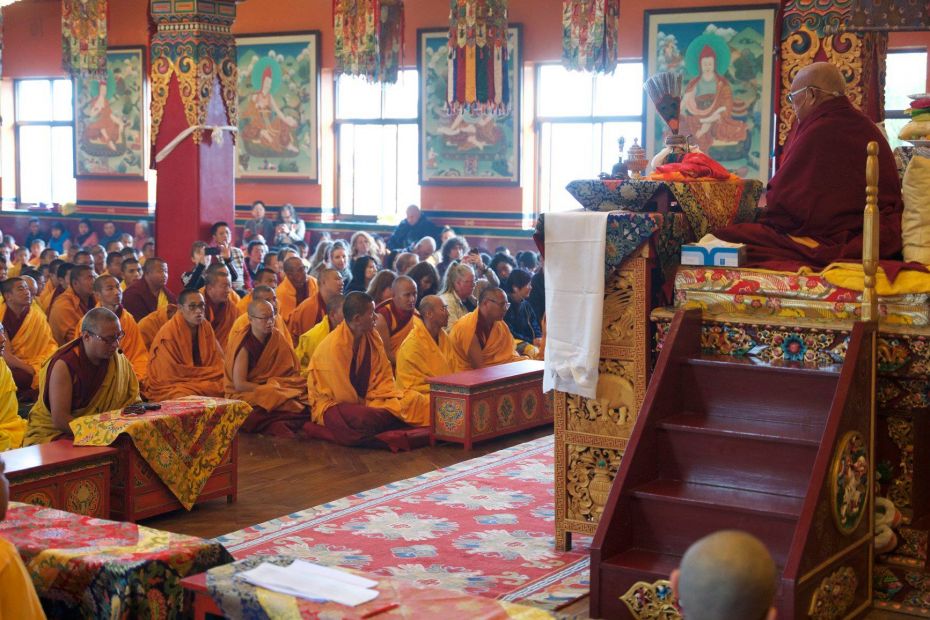
Lama Zopa Rinpoche offering the White Umbrella deity empowerment at Kopan Monastery, Kathmandu, Nepal, February 2019. Photo by Bill Kane.
Lama Zopa Rinpoche advised in “Practices for Pilgrimage”: “Devotion is very important in pilgrimage, otherwise we are no different from a tourist—taking pictures of that place, that rock, that cave, with no change to the mind, the heart.”
The tight itinerary was subject to change and impermanence; each day news came through of special pujas, initiations, and prayers being offered by Lama Zopa Rinpoche in Kopan’s main gompa.
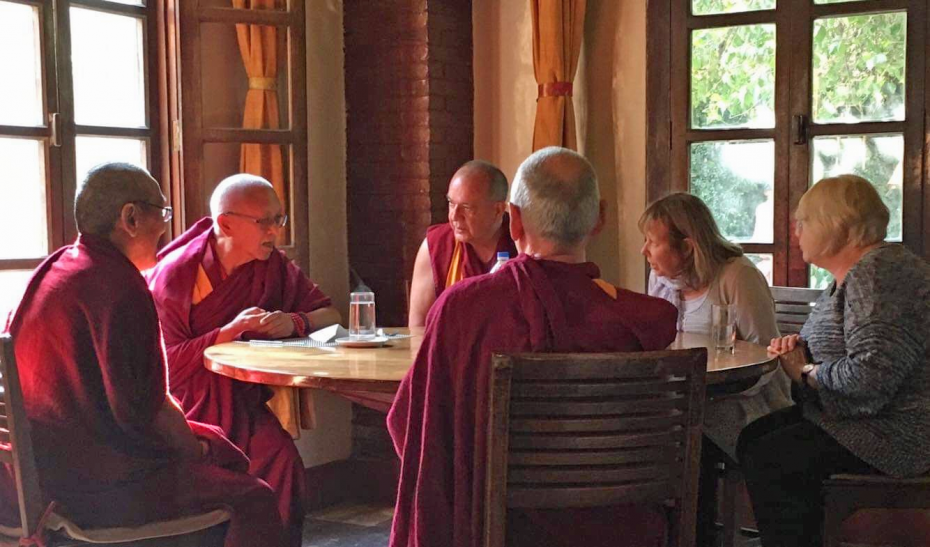
Lama Zopa Rinpoche deep in conversation with Khen Rinpoche Geshe Thubten Chonyi, Ven. Roger Kunsang, Buddha House resident teacher Gen Thubten Dondrub, director Lyndy Abram, and spiritual program coordinator Judy Wagner at Hotel Vajra, Kathmandu, Nepal, February 2019. Photo by Mark Kinnear.
Gen Thubten Dondrub and Peter Wagner, pilgrimage coordinator and Buddha House student, did an excellent job navigating the changes; all of our planned site visits were fulfilled around Rinpoche’s schedule.
Buddha House and Gen Thubten Dondrub hosted a lunch for Lama Zopa Rinpoche; Ven. Roger Kunsang, FPMT CEO; Khen Rinpoche Geshe Thubten Chonyi, Kopan Monastery and Nunnery abbot; Western Sangha; and the group of pilgrims. We shared lunch at Hotel Vajra in Kathmandu, which included singing “Happy Birthday” to Tenzin Ösel Hita using Facetime!
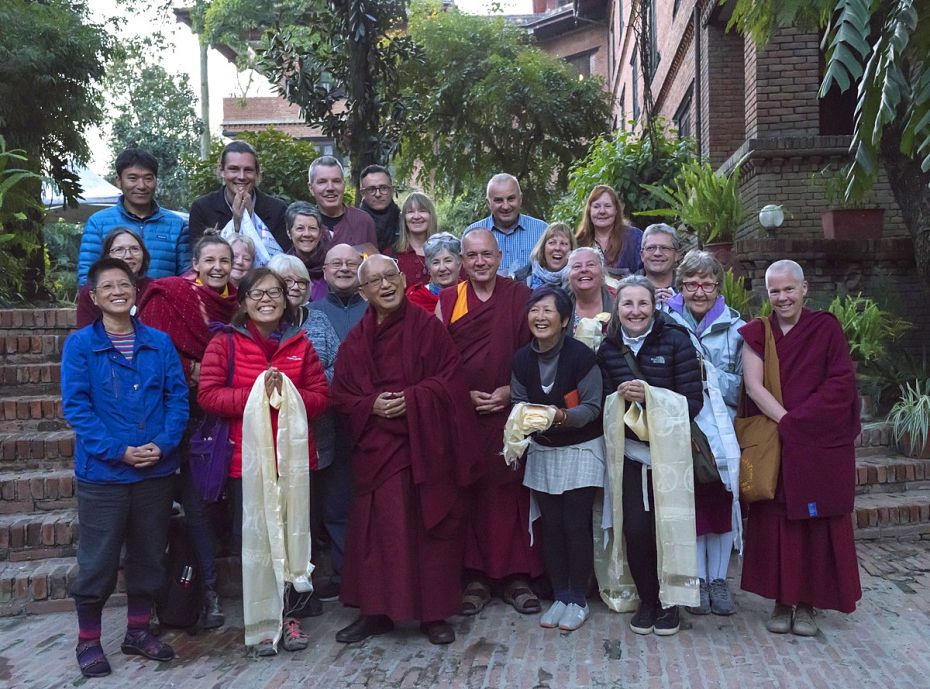
Lama Zopa Rinpoche and pilgrims at Hotel Vajra, Kathmandu, Nepal, February 2019. Photo by Ven. Lobsang Sherab.
This lunch came about due to an offer by Lama Zopa Rinpoche to spend the day with the pilgrims. The day commenced with Rinpoche bestowing the Bodhisattva Vows at Jamchen Lhakhang Monastery, a Sakya monastery at Boudhanath Stupa, and finished twelve hours later after a lengthy circumambulation of Swayambanath Stupa with Rinpoche giving many explanations, offerings, prayer recitations, and dedications along the way.
How amazing—wow, wow, wow!—for the pilgrims to meet and spend time with the precious Guru.

Rinpoche bestowing Bodhisattva Vows at Jamchen Lhakhang Monastery, Boudhanath Stupa, Kathmandu, Nepal, February 2019. Photo by Frank Maraz.
Lama Zopa Rinpoche advised in “Practices for Pilgrimage”: “Actually, on pilgrimage it’s very good to have difficulties because they purify the mind. We have to understand that difficulties purify the negativities; it’s like when we do Vajrasattva retreat and become sick. Think, ‘I am going to this place to purify my mind—to purify all the negative karmas and defilements—and to collect extensive merit, in order to have the realization of lamrim.’
“With such a motivation, when we experience problems or difficulties, these become worthwhile. … Yet if hardships are experienced with the thought of the eight worldly dharmas—with attachment clinging to this life—then there is no special benefit; they only become torture.”
The trip was not without difficulties for most of the pilgrims. From chest to stomach complaints, including knees, hips, and backs, the pilgrims took their turns taking on their purifications with acceptance, knowing how much hardship the great masters of the past bore to practice Dharma.
Lama Zopa Rinpoche advised in “Practices for Pilgrimage”: “One lama made the comment that when the great, holy beings—buddhas, bodhisattvas, and yogis—go on pilgrimage, they bless the place. And when ordinary people go there, they receive blessings from that place. So pilgrimage means to receive blessings from the holy places to inspire our mind to transform into the path.”

Rinpoche giving explanations, prayers, and making offerings with FPMT Australia pilgrims and Sangha at Swayambhunath Stupa, Kathmandu, Nepal, February 2019. Photo by Carole Migalka.
Many holy places were visited including Boudhanath Stupa; Namo Buddha Stupa; Swayambhunath Stupa; holy sites in Sankhu, Pharping, and Patan; and ancient city temples associated with the deities Tara and Vajrayogini.
Khachoe Ghakyil Ling Nunnery (Kopan Nunnery) was also a memorable visit. The nuns were very welcoming as we all stocked up on the incense that is made on site.
Gen Thubten Dondrub included Nagi Gompa in the itinerary; it is located high up in Shivapuri National Park with a panoramic view of the Kathmandu Valley. The national park and nunnery were covered with snow that morning. It was just magical. After completing our practices and prayers in the beautiful little gompa—and devouring a packed lunch from Kopan—the day cleared up, giving us a stunning view of the valley on our return journey.
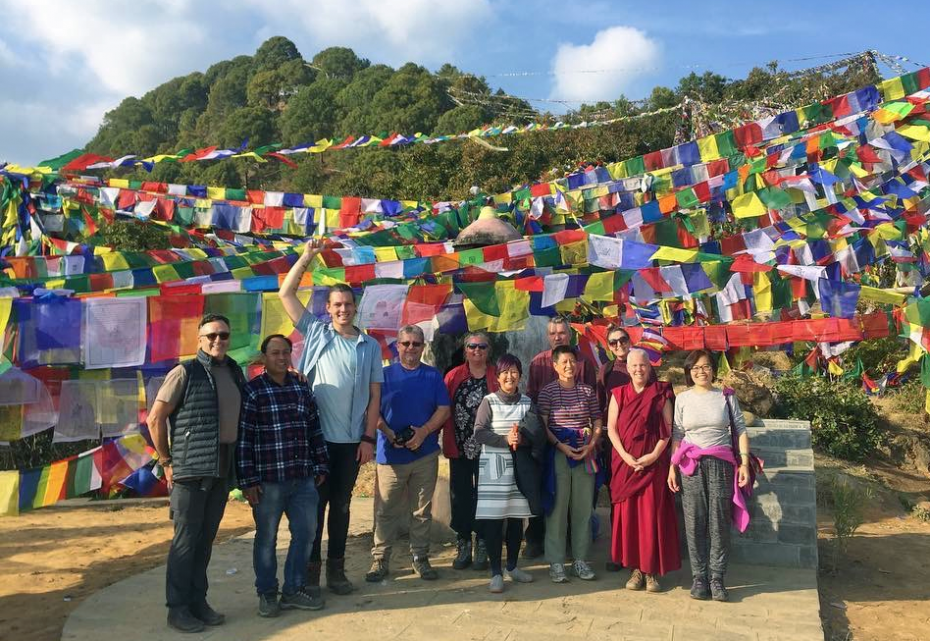
Ven. Joan Nicell with a group of FPMT Australia pilgrims in Pharping, Nepal, February 2019. Photo by Amber Bamjan Tamang.
Our itinerary concluded with a nine-hour jeep ride to the Maratika Caves, also known as Haleshi.
According to Condense Guide to Maratika—prepared by Maratika Lama (Ngawang Chophel Gyatso), a student of the Lawudo Lama, and blessed by Trulshik Rinpoche, one of Lama Zopa Rinpoche’s teachers—Padmasambhava said, “If one visits this great holy place called Haleshi or ‘Astonishing,’ one will not need to experience the lower realms.”

Thubten Rigsel Rinpoche and Tenzin Phuntsok Rinpoche with FPMT Australia pilgrims at Kopan Monastery, Kathmandu, Nepal, February 2019. Photo by Mark Kinnear.
Many thanks go to our compassionate and patient guide Amber Bamjan Tamang, owner of Three Jewels Adventures, for his flexibility and care during the entire pilgrimage. Amber is a Buddhist who holds a master’s degree in culture from Tribhuwan University, Kathmandu. Gen Thubten Dondrub has led four pilgrimages for Australian FPMT centers with Amber as the guide each time.
We also thank Amber’s wonderful team of experienced drivers, who maneuvered the traffic and rocky roads in Kathmandu and the Kathmandu Valley. They also took us through the rugged terrain going to and from the Maratika Caves, which was an experience in itself!
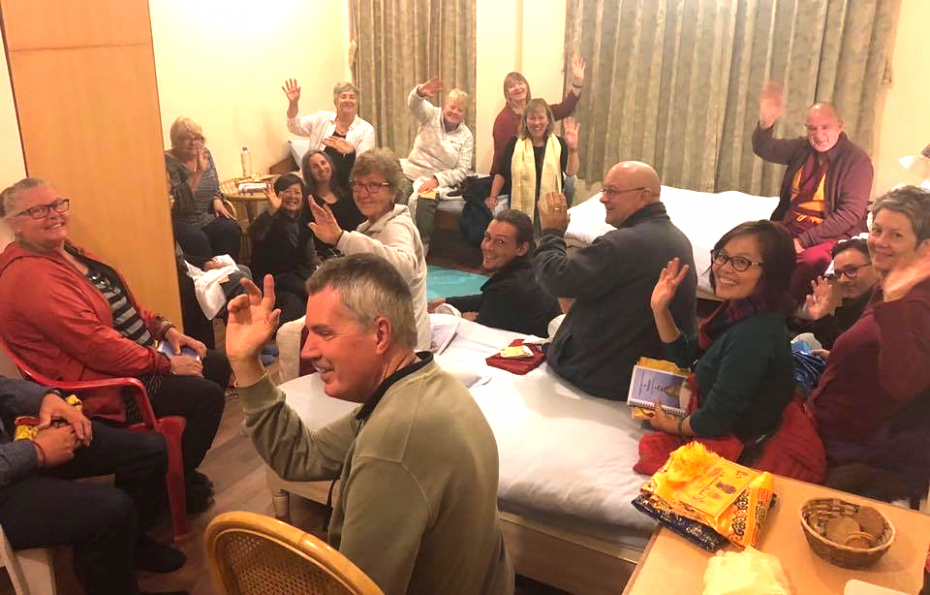
Gen Thubten Dondrub and FPMT Australia pilgrims doing practices on their last night in Nepal, Gen Thubten Dondrub’s room at Kopan Monastery, Kathmandu, Nepal, February 2019. Photo by Carole Migalka.
The “family feeling” (or “pamily peeling” as Lama Yeshe used to say) was truly present at Kopan and for the whole pilgrimage.
We were all so fortunate to have Lama Zopa Rinpoche in residence at Kopan during our visit; to be able to have tea, make offerings, and spend time with Thubten Rigsel Rinpoche and Tenzin Phunstok Rinpoche; and to have the opportunity to connect with pilgrims from other Australian FPMT centers and fellow worldwide travelers who were staying at Kopan, sharing experiences and stories.
Everyone at Kopan was so welcoming and helpful—especially Ani Fran with all her knowledge and assistance during our stay; the wonderful Ven. Joan Nicell for accompanying us to Pharping and leading our practices and prayers that day; Ani Tenzin Namdrol, who is in charge of Lama Zopa Rinpoche’s apartment, for her support with anything that we needed for our pujas and practices at the holy sites; and Ven. Lobsang Lourdup (“Bijay”) and the other monks in the office for all their assistance. They all keep that wonderful “family feeling” alive!
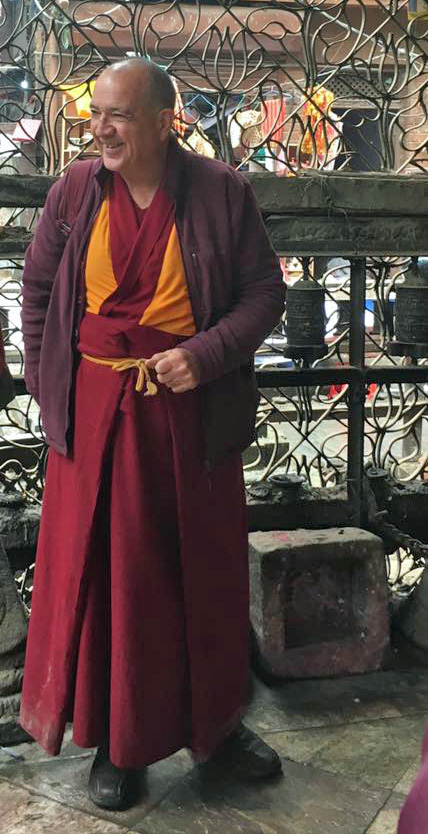
Gen Thubten Dondrub in Nepal, February 2019. Photo by Mark Kinnear.
Lastly and by no means least, a great big “Thank you!” to Gen Thubten Dondrub—for not only leading the pilgrimage—but also for constantly displaying his devotion to Lama Zopa Rinpoche, and his dedication to the FPMT organization through his actions and words.
Gen Thubten Donbrub is such a wonderful humble monk who first met Lama Yeshe and Lama Zopa Rinpoche at Chenrezig Institute back in the mid 1970’s. Gen Thubten Dondrub’s stories, and the references he makes to the lamas during his teachings, helps students feel a strong connection and that FPMT “family feeling.”
Gen Thubten Dondrub has led the November Course at Kopan eight times, teaching hundreds of students from all over the world and influencing so many lives, with some students even going on to take ordination. Staying at Kopan Monastery with this knowledge during the pilgrimage was truly amazing.
We would like to acknowledge and thank Gen Thubten Dondrub for everything he has contributed to help spread the Dharma worldwide over the last forty years. We are so very fortunate at Buddha House to have him as our resident teacher; he has made such a difference since he arrived in 2012.
By the look of all those smiles in these photos, it seems an abundance of blessings were received on the pilgrimage!
* In 2019 Gen Thubten Dondrub requested Buddha House students formally refer to him as “Gen Thubten Dondrub.” He shared, “Usually monks and nuns of the FPMT are referred to as ‘Venerable.’ I have always found this term uncomfortable as it is a very exalted term and is used in the Catholic Church to refer to someone who is in line to be canonized as a saint. When I was in Taiwan I learned that every monk and nun was addressed as ‘Fa Shr’ from the moment they were ordained. The term means ‘Dharma teacher.’ The closest Tibetan equivalent is ‘ge.gen,’ often abbreviated to ‘Gen’ or ‘Gen-la.’ It is polite and friendly. So when people ask how to address me, I suggest using that term. It seems much more appropriate than ‘Venerable.'”
For more information about Buddha House, visit their website:
http://buddhahouse.org
- Home
- News/Media
- Study & Practice
- About FPMT Education Services
- Latest News
- Programs
- New to Buddhism?
- Buddhist Mind Science: Activating Your Potential
- Heart Advice for Death and Dying
- Discovering Buddhism
- Living in the Path
- Exploring Buddhism
- FPMT Basic Program
- FPMT Masters Program
- FPMT In-Depth Meditation Training
- Maitripa College
- Lotsawa Rinchen Zangpo Translator Program
- Universal Education for Compassion & Wisdom
- Online Learning Center
- Prayers & Practice Materials
- Overview of Prayers & Practices
- Full Catalogue of Prayers & Practice Materials
- Explore Popular Topics
- Benefiting Animals
- Chenrezig Resources
- Death & Dying Resources
- Lama Chopa (Guru Puja)
- Lama Zopa Rinpoche: Compendium of Precious Instructions
- Lama Zopa Rinpoche: Life Practice Advice
- Lama Zopa Rinpoche Practice Series
- Lamrim Resources
- Mantras
- Prayer Book Updates
- Purification Practices
- Sutras
- Thought Transformation (Lojong)
- Audio Materials
- Dharma Dates – Tibetan Calendar
- Translation Services
- Publishing Services
- Teachings and Advice
- Find Teachings and Advice
- Lama Zopa Rinpoche Advice Page
- Lama Zopa Rinpoche: Compendium of Precious Instructions
- Lama Zopa Rinpoche Video Teachings
- ༧སྐྱབས་རྗེ་བཟོད་པ་རིན་པོ་ཆེ་མཆོག་ནས་སྩལ་བའི་བཀའ་སློབ་བརྙན་འཕྲིན།
- Podcasts
- Lama Yeshe Wisdom Archive
- Buddhism FAQ
- Dharma for Young People
- Resources on Holy Objects
- Ways to Offer Support
- Centers
- Affiliates Area
- Teachers
- Projects
- Charitable Projects
- Make a Donation
- Applying for Grants
- News about Projects
- Other Projects within FPMT
- Support International Office
- Projects Photo Galleries
- Give Where Most Needed
- FPMT
- Shop
Translate*
*powered by Google TranslateTranslation of pages on fpmt.org is performed by Google Translate, a third party service which FPMT has no control over. The service provides automated computer translations that are only an approximation of the websites' original content. The translations should not be considered exact and only used as a rough guide.Once you realize the true evolution of your mental problems, you’ll never blame any other living being for how you feel.







